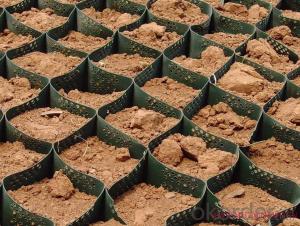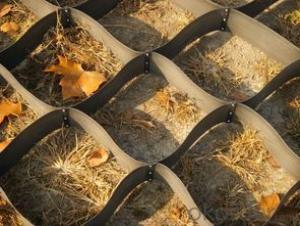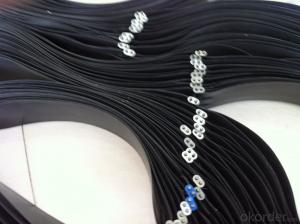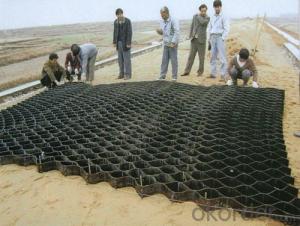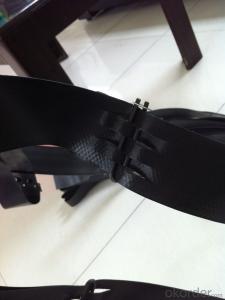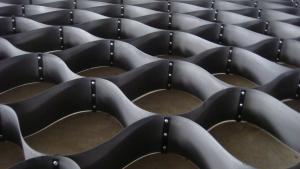Geocell for Driveway/Plastic Geocell for Pretecting River Bed
- Loading Port:
- Qingdao
- Payment Terms:
- TT OR LC
- Min Order Qty:
- 5000 m²
- Supply Capability:
- 300000 m²/month
OKorder Service Pledge
OKorder Financial Service
You Might Also Like
Description Of Plastic Geocell:
Hot Sale HDPE Geocell is a new type of high-strength geosynthetics, which is popular in domestic and abroad. It is a kind of three-dimensional network structure shaped by high-strength HDPE sheets through ultrasonic welding of high strength. Currently, it is being widely used in construction, such as highway, railway, bridge, dyke, etc.
Main Features of Plastic Geocell:
Light weight, wear-resistant, chemical stability, light oxidation aging, anti-acid/alkali corrosion, applied to different geological conditions, such as saline soil, desert, etc.
Wide temperature range, high tensile strength, good rigidity and toughness, good load capacity and anti-erosion ability.
Size is relatively stable, change the height and welding distance can meet the needs of different projects.
Retractile, easy to transport.
Easy to use, can use the local materials and achieve rapid construction, reduce construction costs.
Can be used repeatedly.
Specifications of Plastic Geocell:
Product Type | Height(mm) | Welding Distance(mm) | Thickness (mm) | Seam Peel Strength of Welding Points(N/cm) | Tensile Strength of Connection of Cells(N/cm) | Tensile Strength at Yield of Each Sheet(N/Mpa) |
Flat and Not Perforated | 50≤H≤250 | 330≤A≤1000 | 1.1/1.2 | ≥100 | ≥120 | ≥20 |
Flat and Perforated | 50≤H≤250 | 330≤A≤1000 | 1.1/1.2 | ≥100 | ≥120 | ≥20 |
Embossed and Not Perforated | 50≤H≤250 | 330≤A≤1000 | 1.5 | ≥100 | ≥120 | ≥20 |
Embossed and Perforated | 50≤H≤250 | 330≤A≤1000 | 1.5 | ≥100 | ≥120 | ≥20 |
Remarks: Width of the product can be made according to the customer’s demand, and the other special standards will be carried out by agreement or contact. (The product has passed CE & GOST-R & SGS certification) | ||||||
Application of Plastic Geocell:
To stable the roadbed of highway/railway.
To bear the load of dyke, retaining wall.
To improve the watercourse of shallow river.
To support the pipeline and sewer.
To be used as independent wall, wharf and breakwater, etc..
To be used for the regulation of the desert, beaches, river bed and river bank.
IMages of Plastic Geocell:
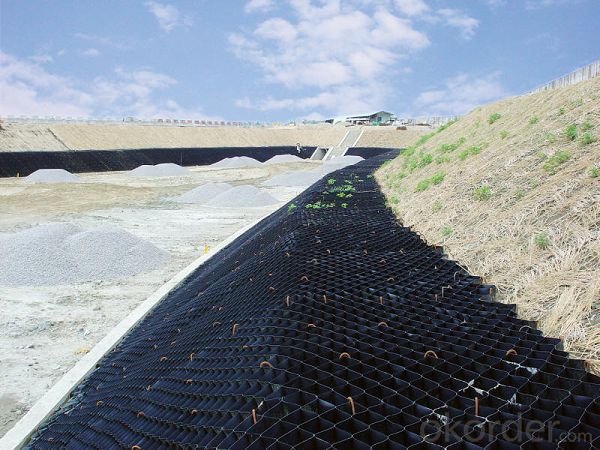

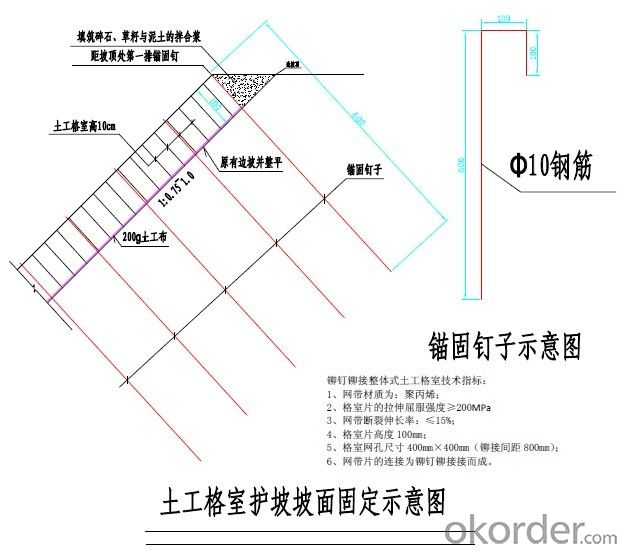
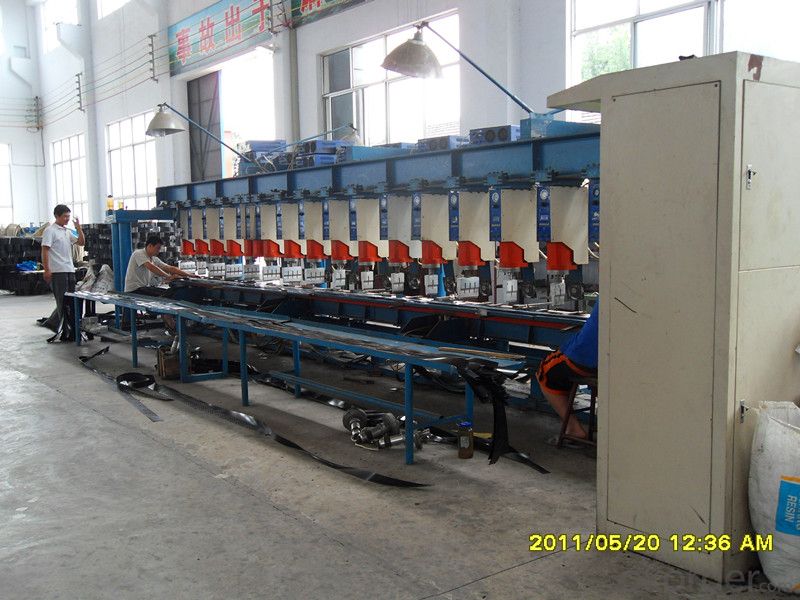
FAQ:
1. Do you supply free samples for customers?
Yes,we will supply free samples for you.Please send your address for us.
2. How Many years experience do you have?
We have been exported to more than 20 countries in the past 15 years.
3. How long do we usually reply your request?
We always reply our customer within 24 hours.
- Q:How do geotextiles help with reinforcement of soil slopes?
- Geotextiles help with the reinforcement of soil slopes by providing a stable and strong barrier that prevents soil erosion. They act as a protective layer, distributing the weight and forces evenly, enhancing the stability of the slope. Additionally, geotextiles separate the soil layers, preventing intermixing and promoting drainage, which further contributes to the reinforcement of the slope.
- Q:Can geotextiles be used in wastewater treatment applications?
- Yes, geotextiles can be used in wastewater treatment applications. They are commonly used in filtration systems to separate solids from liquids and provide support for various treatment processes. Geotextiles can enhance the efficiency of wastewater treatment by improving filtration, reducing clogging, and increasing overall system performance.
- Q:Can geotextiles be used for reinforcement of earthen dams?
- Yes, geotextiles can be used for the reinforcement of earthen dams. Geotextiles are commonly employed in dam construction projects to enhance the stability, strength, and erosion resistance of earthen embankments. They act as a barrier, preventing the loss of soil particles while still allowing for water drainage, thereby improving the overall performance and longevity of the dam.
- Q:Are geotextiles suitable for use in erosion control mats for revegetation?
- Yes, geotextiles are suitable for use in erosion control mats for revegetation. Geotextiles are designed to stabilize soil and prevent erosion by providing a barrier against water and wind. They also promote vegetation growth by allowing water and nutrients to penetrate the soil while protecting the roots from erosion. Overall, geotextiles can be an effective solution for erosion control in revegetation projects.
- Q:What are the specifications for geotextiles used in geosynthetic tubes?
- The specifications for geotextiles used in geosynthetic tubes may vary depending on the specific application and project requirements. However, some common specifications include factors such as the tensile strength, permeability, UV resistance, puncture resistance, and filtration properties. It is important to consider the specific project conditions and engineering design to determine the suitable specifications for geotextiles used in geosynthetic tubes.
- Q:How do geotextiles help with subgrade separation in pavement systems?
- Geotextiles help with subgrade separation in pavement systems by acting as a barrier between the subgrade soil and the overlying aggregate layers. This prevents the mixing of fine subgrade soil particles with the coarser aggregate materials, thereby enhancing the stability and performance of the pavement. Additionally, geotextiles also help in distributing load stresses more evenly, reducing the potential for subgrade deformation and extending the lifespan of the pavement system.
- Q:Can geotextiles be used in the construction of artificial islands?
- Yes, geotextiles can be used in the construction of artificial islands. Geotextiles are permeable fabrics that can provide effective soil stabilization, erosion control, and filtration. They can be used as a protective layer between the island's foundation and the surrounding water, preventing erosion and promoting stability. Additionally, geotextiles can assist in the drainage system of the island, allowing excess water to flow through while retaining the soil. Thus, geotextiles are a valuable tool in the construction and maintenance of artificial islands.
- Q:How are geotextiles affected by biological factors?
- Geotextiles can be affected by biological factors such as the growth of vegetation and the presence of microorganisms. Vegetation can penetrate and grow through geotextiles, reducing their effectiveness in providing separation and reinforcement. In addition, microorganisms can cause degradation of the geotextile material over time, compromising its structural integrity. Therefore, it is important to consider and manage these biological factors when using geotextiles in various applications.
- Q:What are the challenges associated with the installation of geotextiles?
- Some challenges associated with the installation of geotextiles include ensuring proper alignment and placement of the fabric, securing it to the ground to prevent shifting or movement, and properly overlapping and connecting multiple pieces of geotextile to create a continuous barrier. Other challenges may include dealing with uneven or unstable soil conditions, working in difficult terrain or access areas, and ensuring the geotextile does not get damaged during the installation process. Additionally, the selection and installation of appropriate anchoring methods and the need for specialized equipment or expertise can also pose challenges.
1. Manufacturer Overview |
|
|---|---|
| Location | |
| Year Established | |
| Annual Output Value | |
| Main Markets | |
| Company Certifications | |
2. Manufacturer Certificates |
|
|---|---|
| a) Certification Name | |
| Range | |
| Reference | |
| Validity Period | |
3. Manufacturer Capability |
|
|---|---|
| a)Trade Capacity | |
| Nearest Port | |
| Export Percentage | |
| No.of Employees in Trade Department | |
| Language Spoken: | |
| b)Factory Information | |
| Factory Size: | |
| No. of Production Lines | |
| Contract Manufacturing | |
| Product Price Range | |
Send your message to us
Geocell for Driveway/Plastic Geocell for Pretecting River Bed
- Loading Port:
- Qingdao
- Payment Terms:
- TT OR LC
- Min Order Qty:
- 5000 m²
- Supply Capability:
- 300000 m²/month
OKorder Service Pledge
OKorder Financial Service
Similar products
New products
Hot products
Related keywords
